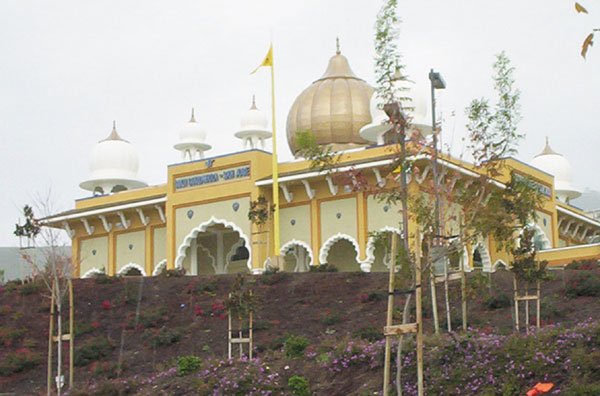Next Monday, March 14, is Sikh New Year’s Day, beginning the
year 537 of the Nanakshani Era. With this in mind, here is some
information about one of the most distinctive religious buildings
in the South Bay area.
Next Monday, March 14, is Sikh New Year’s Day, beginning the year 537 of the Nanakshani Era. With this in mind, here is some information about one of the most distinctive religious buildings in the South Bay area.
In August, a striking “gurdwara” (temple) opened in the foothills of the Evergreen district. This 20,000-square-foot complex, built at the cost of $10 million, is reportedly the largest in the United States.
Located at 3636 Murillo Avenue, the temple’s sheet-metal domes are visible from many neighboring streets.
While the current facilities can accommodate 1,500 worshippers, plans are to add 70,000 square feet of additional buildings as finances permit.
The temple’s main building has doors facing all four directions, symbolizing that people from everywhere are welcome.
It is surrounded by pools and fountains. Inside the lobby is a room to leave one’s shoes as well as a collections of scarves for both men and women to cover their heads.
The main building’s upstairs has several rooms, one of which houses exhibits about the history and practice of Sikhism.
The side buildings, connected by covered walkways, are very versatile, with moving walls to provide separate spaces. One houses the temple’s “langar,” a kitchen/dining area providing free meals throughout the day.
There are three gurdwaras in the East Bay, but the South Bay’s growing Sikh population of some 10,000 has had its own since 1985. The new temple replaces a previous facility on White Road which was outgrown.
Although Sikhism is a major world religion (20 million members, at least 250,000 in California, including more than 50,000 in the Bay Area), most people may not know much about this faith.
Sikhism was founded in the Punjab region of northern India in the 15th century by Guru (teacher) Nanak. He wrote beautiful devotional hymns and set out such basic doctrines as worship of one god and the practice of virtues like honesty, compassion, patience and generosity.
Sikhism combines elements of Hinduism and Islam. Nanak taught that in both these religions the truth about God was obscured by unnecessary ritual.
He believed that one could come closer to God through meditation and devotion rather than ceremonies. He rejected India’s caste system and taught that all people are equal while emphasizing that salvation comes through rejection of worldly values and worship of God and practicing tolerance and brotherly love toward all.
Guru Nanak was succeeded over the centuries by nine other gurus who developed the religion more fully by building temples, providing for observation of festivals, and compiling the sacred scripture known as the “Adi Granh.”
Worship services feature singing of hymns with musical accompaniment, lectures, prayer and distribution of “Ka’r’ah,” a sweet bread pudding. Sikhs remove their shoes and cover their heads during worship to show respect.
Persecution by the mughal (Muslim) authorities in India led to the founding of a Sikh self-defense brotherhood called the “Khalsa” (meaning “pure”). Members vowed to avoid liquor, drugs, tobacco and to devote themselves to prayer. Sikhs who desire to join this order go through a baptism rite and take the name of “Singh” (meaning “lion”).
This led to the distinctive appearance of Sikh men. It involves the five K’s or emblems: uncut hair and beards (hence the wearing of turbans), a comb to hold the hair in place, a dagger, a steel bracelet and pants that end below the knees.
At the end of the 18th century, Sikhs finally achieved independence under their own maharajah, but the British annexed the Punjab into India in 1849. Since then, there have been many bloody conflicts between the Indian government and Sikh separatists who wish to establish an independent nation called Khalistan from the Indian state of Punjab.













